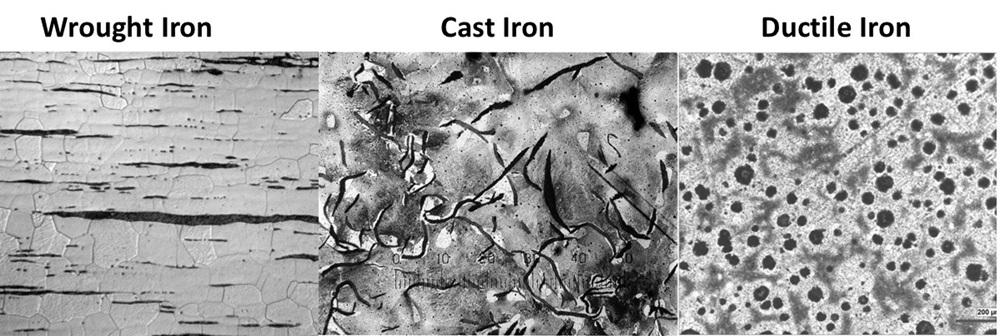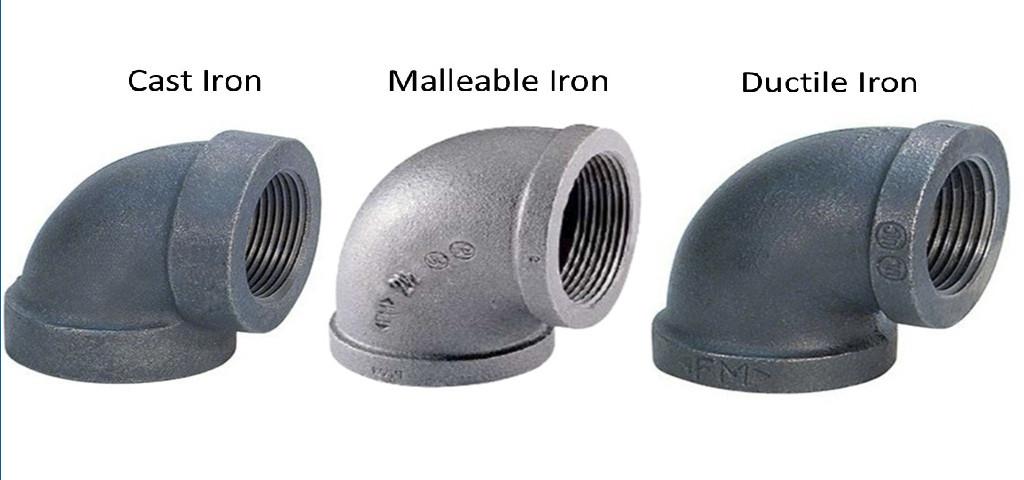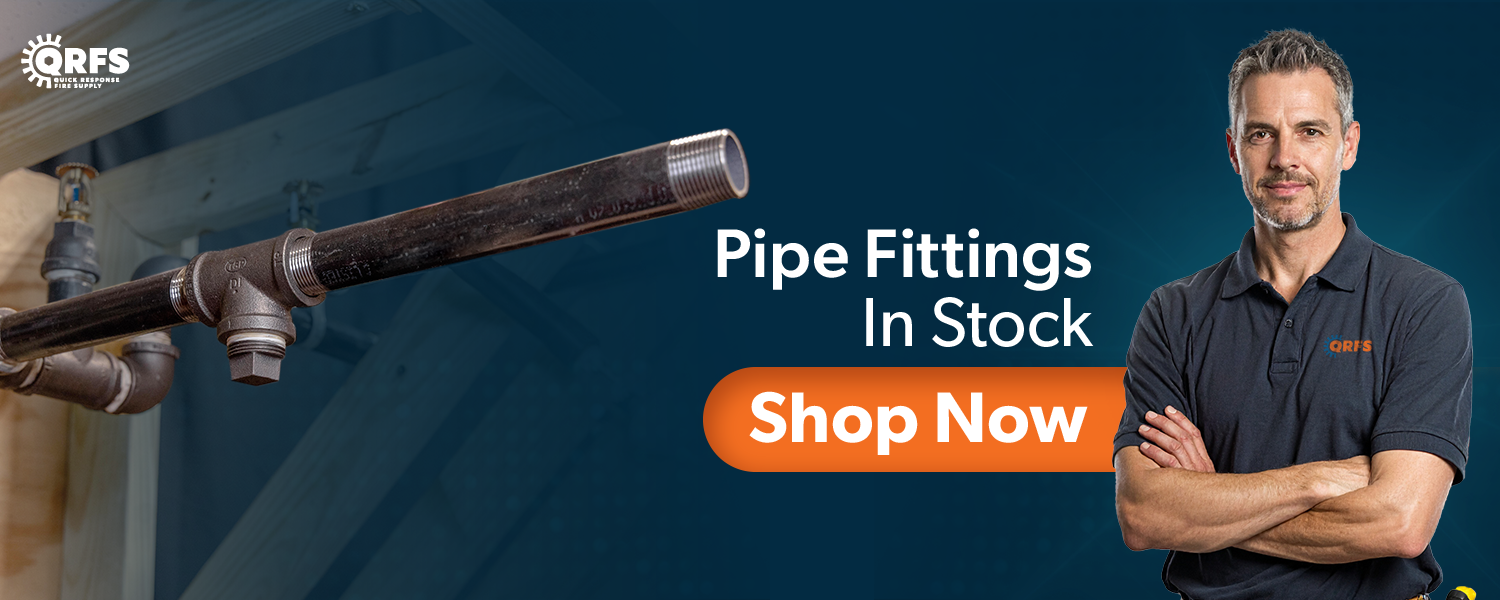Several types are used in fire sprinkler systems—here’s why pros choose a specific material and when
Aboveground fire sprinkler pipes used in commercial systems are most often made of steel, and the connections and fittings for these steel pipes can be grooved or threaded. In either case, the pipe is cut to length, machined, and joined with premade fittings. Threaded fittings (tees, elbows, etc.) are usually made from one of three forms of iron: malleable iron, ductile iron, or cast iron fittings. So, which one do pros usually choose and why?
The decision is typically determined by two key factors: quality and cost. In terms of raw quality, ductile and malleable irons are higher quality in terms of brittleness and weight; cast iron is brittle with little tensile strength. Unsurprisingly, cast iron costs the least out of the three options. But there are more factors at play, and many fire protection pros still use cast iron. So, read on to learn more about:
- The properties of iron fittings
- Cast iron fittings: pros and cons
- Malleable iron fittings: pros and cons
- Ductile iron fittings: pros and cons
Check out QRFS’s selection of fittings, including CPVC fittings, threaded iron fittings, and grooved fittings! Our inventory is expanding rapidly, so if you don’t see what you need in our online inventory, just contact us!
The properties of iron fittings
To properly compare and contrast cast iron, malleable iron, and ductile iron fittings, we need a vocabulary to describe their properties. And key to establishing this language is understanding how carbon influences the strength of iron and where burst pressure ratings come from.
Carbon structure, compressive strength, and tensile strength
Common iron isn’t just made of the pure element iron. Instead, it contains small amounts of other elements interspersed within the iron, and perhaps the most important of these is carbon. The properties of a specific iron—such as hardness, compressive strength, tensile strength, and ductility—are determined by the microstructure formed in a particular mixture of carbon and iron.
On its own, iron is actually a softer metal than many people might think. For example, iron with less than 0.2% carbon is called “wrought iron” or “pure iron” and can be rather flexible. Additional carbon imparts hardness and compressive strength to iron. An iron alloy containing 1.7% or more carbon is called “pig iron,” an umbrella term that includes cast iron, malleable iron, and ductile iron.

Now, hardness and compressive strength are great. But a concrete paver has high hardness and compressive strength, yet a karate black belt can smash through multiple pavers with his hands. Without tensile strength and ductility (the ability to deform plastically without breaking), concrete—much like high-carbon iron—is brittle. In concrete, a lattice made of iron rebar fixes this problem. With iron, changes to the carbon lattice do the same job. Malleable iron and ductile iron are both treated in different ways to achieve these improved properties—more on that later.
Pressure resistance rating
One property influenced by tensile strength and ductility is pressure resistance: pipe fittings made from less brittle alloys tend to withstand higher internal pressures.
To understand pressure ratings for pipe fittings, it’s important to know about the rules in a few industry and material standards. NFPA 13: Standard for the Installation of Sprinkler Systems (2025 edition) mandates that threaded iron pipe fittings must conform to specific American Society of Mechanical Engineers (ASME) manufacturing standards for size and quality to be used in a fire protection system. These are:
- For cast iron: ASME B16.4: Gray Iron Threaded Fittings: Classes 125 and 250
- For malleable iron: ASME B16.3: Malleable Iron Threaded Fittings, Classes 150 and 300
Ductile iron dimensions also conform to ASME B16.3. These ASME standards describe the dimensions for different weights of fitting: standard weight and extra-heavy weight. Extra-heavy-weight fittings can withstand higher pressures, and NFPA 13 (16.8.3) lists the maximum pressures for malleable iron and cast iron fittings for these two weights. Manufacturers often list the “class” of a fitting rather than weight; the correspondence is:
- For cast iron, Class 125 is standard weight, and Class 250 is extra heavy weight.
- For malleable iron and ductile iron, Class 150 is standard weight, and Class 300 is extra-heavy weight.
As you might expect, ductile and malleable irons have higher pressure ratings than cast iron.
Unlike many parts of fire sprinkler systems, there is no requirement in NFPA 13 (7.4.1) for metallic pipe or fittings to be “listed” (tested and certified for use in fire protection; e.g., UL Listed or FM Approved) as long as they conform to the appropriate standards, some of which are the ASME standards we’ve mentioned above. However, many fittings are listed anyway, and NFPA 13 allows system designers and installers to rely on the pressure ratings provided by the listing (16.8.3.5). For example, ductile iron fittings are often listed to withstand quite high pressures, such as 500 PSI.
Cast iron fittings: pros and cons
Among iron fittings, cast iron is the lowest-quality and lowest-priced option. However, that doesn’t make this material bad—otherwise, NFPA standards wouldn’t permit the use of cast iron fire sprinkler fittings. Cast iron fittings produced in conformity with ASME B16.4are perfectly acceptable for use in fire sprinkler systems.
Cast iron contains 2-5% carbon, plus silicone and trace amounts of other elements. It is produced by heating iron with coke and limestone and then pouring the molten mixture into molds. The end result is very hard and durable under a compressive load, where forces push on and smoosh a material. However, cast iron is brittle under tension and can break without deforming under heavy tensile loads, which are when forces pull or stretch a material. Cast iron is also not machinable or forgeable.
Metallurgically, these downsides can be traced back to its carbon structure, which is flaky. The problems of a flaky, brittle carbon structure are solved in malleable and ductile iron. Nevertheless, as long as a cast iron fitting meets standards specified in NFPA 13, it can handle the pressures in fire sprinkler systems.
NFPA 13 (16.8.3)lays out basic pressure-tolerance and size limits for cast iron threaded fittings:
- Standard-weight pattern cast iron fittings that are 2 inches or smaller can be used with pressures up to 300 PSI.
- Extra-heavy pattern cast iron fittings that are bigger than 2 inches can be used with pressures up to 175 PSI.
According to an industry pro we spoke with, cast iron is often favored in the eastern half of the USA, especially in big cities like Boston or New York. Besides its lower cost, cast iron is made domestically, which can be important for unions or government projects.
Malleable iron fittings: pros and cons
You could say that malleable iron is a kind of cast iron rather than a wholly different metal. That’s because malleable iron is produced in much the same way as cast iron, with molten iron poured into molds. But to make malleable iron, an annealing step is performed.
During annealing, the cast iron component is heated to a high temperature, held at it for an extended period, and then cooled slowly. This process converts the flaky carbon structure into spherical graphite deposits that add ductility and tensile strength to the cast iron. Malleable iron fittings used for fire sprinkler systems should conform to ASME B16.3.
Per NFPA 13, there are two pressure/size rules for malleable iron fittings:
- Standard-weight pattern malleable iron fittings that are 6 inches or smaller can be used with pressures up to 300 PSI.
- Extra-heavy pattern malleable iron fittings that are bigger than 6 inches can be used with pressures up to 175 PSI.
Note that US-based pros and projects tend to use malleable iron rather than the next option, ductile iron, as the latter is generally made overseas and is perceived as an international fitting. More on that in a second …
Ductile iron fittings: pros and cons
Compared to cast iron and malleable iron, ductile iron is extremely modern. It was first discovered in 1943 and achieves performance benefits similar to those enjoyed by malleable iron. However, where malleable iron achieves a favorable carbon structure by high-heat annealing, ductile iron uses small amounts of nodulizing elements, such as magnesium, to promote the formation of graphite nodules. These graphite nodules impart ductility and tensile strength to the iron—both of which are superior to those found in cast iron or malleable iron.
Despite being the highest-quality option, ductile iron fittings can actually be quite affordable for two reasons. First, the manufacturing process does not involve the extended high-temperature annealing step used for malleable iron. Second, there is little to no domestic ductile iron production in the USA—it’s all imported from places where manufacturing costs less. That can be an advantage or a disadvantage depending on any buy-American procurement rules a project is bound by, as well as the tariff climate.
As long as a specific material meets industry standards, the choice is yours
Cast iron, malleable iron, and ductile iron threaded fittings each have their advantages. The “best” one depends on your project needs. Do you need a particularly high pressure rating (something rare for fire sprinkler projects)? Ductile or malleable iron might be a better choice. Are you worried more about cost? Cast iron fittings can work fine. Is domestic manufacturing important to you, or a project requirement? Don’t choose ductile iron—cast iron or malleable iron fit the bill.
Whichever option you choose, QRFS can help you secure the fire protection parts you need. Check out our catalog of pipe, fittings, and sprinklers for your next project. Our inventory is expanding rapidly, so if you need something you don’t see on the site, get in touch!
This blog was originally posted at blog.qrfs.com. If this article helped you, check us out on X @QuickResponseFS.



